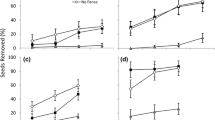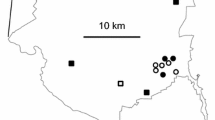Abstract
Seed predation may reduce recruitment in populations that are limited by the availability of seeds rather than microsites. Fires increase the availability of both seeds and microsites, but in plants that lack a soil- or canopy-stored seed bank, post-fire recruitment is often delayed compared to the majority of species. Pyrogenic flowering species, such as Telopea speciosissima, release their non-dormant seeds more than 1 year after fire, by which time seed predation and the availability of microsites may differ from that experienced by plants recruiting soon after fire. I assessed the role of post-dispersal seed predation in limiting seedling establishment after fire in T. speciosissima, in southeastern Australia. Using a seed-planting experiment, I manipulated vertebrate access to seeds and the combined cover of litter and vegetation within experimental microsites in the 2 years of natural seed fall after a fire. Losses to vertebrate and invertebrate seed predators were rapid and substantial, with 50% of seeds consumed after 2 months in exposed locations and after 5 months when vertebrates were excluded. After 7 months, only 6% of seeds or seedlings survived, even where vertebrates were excluded. Removing litter and vegetation increased the likelihood of seed predation by vertebrates, but had little influence on losses due to invertebrates. Microsites with high-density vegetation and litter cover were more likely to have seed survival or germination than microsites with low-density cover. Recruitment in pyrogenic flowering species may depend upon the release of seeds into locations where dense cover may allow them to escape from vertebrate predators. Even here, conditions suitable for germination must occur soon after seed release for seeds to escape from invertebrate predators. Seed production will also affect recruitment after any one fire, while the ability of some juvenile and most adult plants to resprout after fire buffers populations against rapid declines when there is little successful recruitment.




Similar content being viewed by others
References
Abrahamson WG (1999) Episodic reproduction in two fire-prone palms, Serenoa repens and Sabal etonia (Palmae). Ecology 80:100–115
Andersen AN (1987) Effects of seed predation by ants on seedling densities at a woodland site in SE Australia. Oikos 48:171–174
Andersen AN (1988) Immediate and longer-term effects of fire on seed predation by ants in sclerophyllous vegetation in south-eastern Australia. Aust J Ecol 13:285–293
Andersen AN, Yen AL (1985) Immediate effects of fire on ants in the semi-arid mallee region of north-western Victoria. Aust J Ecol 10:25–30
Auld TD (1986) Post-fire demography in the resprouting shrub Angophora hispida (Sm.) Blaxell: flowering, seed production, dispersal, seedling establishment and survival. P Linn Soc NSW 109:259–269
Auld TD, Denham AJ (1999) The role of ants and mammals in dispersal and post-dispersal seed predation of the shrubs Grevillea (Proteaceae). Plant Ecol 144:201–213
Auld TD, Denham AJ (2001) The impact of seed predation by mammals on post-fire seed accumulation in the endangered shrub Grevillea caleyi (Proteaceae). Biol Conserv 97:377–385
Auld TD, O’Connell MA (1989) Changes in predispersal seed predation levels after fire for two Australian legumes, Acacia elongata and Sphaerolobium vimineum. Oikos 54:55–59
Auld TD, O’Connell MA (1991) Predicting patterns of post-fire germination in 35 eastern Australian Fabaceae. Aust J Ecol 16:53–70
Bond WJ, van Wilgen BW (1996) Fire and plants, 1st edn. Chapman and Hall, London
Borchert M (2004) Vertebrate seed dispersal of Marah macrocarpus (Cucurbitaceae) after fire in the western transverse ranges of California. Ecoscience 11:463–471
Borchert M (2006) Seed fate of Marah macrocarpus (Cucurbitaceae) following fire: do seedlings recruit from rodent burrows? Ecol Res 21:641–650
Bradstock RA (1995) Demography of woody plants in relation to fire: Telopea speciosissima. P Linn Soc NSW 115:25–33
Campbell ML, Clarke PJ (2006) Seed dynamics of resprouting shrubs in grassy woodlands: seed rain, predators and seed loss constrain recruitment potential. Austral Ecol 31:1016–1026
Christensen NL, Muller CH (1975) Effects of fire on factors controlling plant growth in Adenostoma chaparral. Ecol Monogr 45:29–55
Clark BK, Clark BS, Jacobi EA (1991) Ability of prairie rodents to find seeds in plant litter. Am Midl Nat 126:385–391
Curran LM, Webb CO (2000) Experimental tests of the spatiotemporal scale of seed predation in mast-fruiting Dipterocarpaceae. Ecol Monogr 70:129–148
Denham AJ (2007) Seedling establishment in a pyrogenic flowering species: the role of time-since-fire, litter and post-dispersal seed predation. MSc thesis. University of Wollongong
Denham AJ, Auld TD (2002) Flowering, seed dispersal, seed predation and seedling recruitment in two pyrogenic flowering resprouters. Aust J Bot 50:545–557
Denham AJ, Whelan RJ (2000) Reproductive ecology and breeding system of Lomatia silaifolia (Proteaceae) following a fire. Aust J Bot 48:261–269
Eriksson O, Ehrlen J (1992) Seed and microsite limitation of recruitment in plant populations. Oecologia 91:360–364
Gill AM, Ingwersen F (1976) Growth of Xanthorrhoea australis R. Br. in relation to fire. J Appl Ecol 13:195–203
Goldingay RL (2000) Further assessment of pollen limitation in waratah (Telopea speciosissima). Aust J Bot 48:209–214
Harden GJ (2002) Flora of New South Wales, vol 2, 2nd edn. New South Wales University Press, Sydney
Keeley JE (1987) Role of fire in seed germination of woody taxa in California chaparral. Ecology 68:434–443
Keeley JE (1991) Seed germination and life history syndromes in the California chaparral. Bot Rev 57:81–116
Keeley JE (1993) Smoke-induced flowering in the fire-lily Cyrtanthus ventricosus. S Afr J Bot 59:638
Keith DA (1996) Fire-driven extinction of plant populations: a synthesis of theory and review of evidence from Australian vegetation. P Linn Soc NSW 116:37–78
Keith DA (2004) Ocean shores to desert dunes: the native vegetation of New South Wales. Department of Environment and Conservation (NSW), Hurstville, Australia
Lamont BB, Le Maitre DC, Cowling RM, Enright NJ (1991) Canopy seed storage in woody plants. Bot Rev 57:277–317
Le Maitre DC, Brown PJ (1992) Life cycles and fire-stimulated flowering in geophytes. In: van Wilgen BW, Richardson DM, Kruger FJ, van Hensenbergen HJ (eds) Fire in South African mountain fynbos. Ecological Studies, vol 93. Springer Verlag, Berlin, pp 145–160
Manson RH, Stiles EW (1998) Links between microhabitat preferences and seed predation by small mammals in old fields. Oikos 82:37–50
Moles AT, Westoby M (2004) Seed mass and seedling establishment after fire in Ku-ring-gai Chase National Park, Sydney, Australia. Austral Ecol 29:383–390
Munzbergova Z, Herben T (2005) Seed, dispersal, microsite, habitat and recruitment limitation: identification of terms and concepts in studies of limitations. Oecologia 145:1–8
Myerscough PJ, Clarke PJ, Skelton NJ (1996) Plant coexistence in coastal heaths: habitat segregation in the post-fire environment. Aust J Ecol 21:47–54
Myster RW, Pickett STA (1993) Effects of litter, distance, density and vegetation patch type on postdispersal tree seed predation in old fields. Oikos 66:381–388
O’Dowd DJ, Gill AM (1984) Predator satiation and site alteration following fire: mass reproduction of alpine ash (Eucalyptus delegatensis) in southeastern Australia. Ecology 65:1052–1066
Ooi MKJ, Auld TD, Whelan RJ (2004) Delayed post-fire seedling emergence linked to season: a case study with Leucopogon species (Epacridaceae). Plant Ecol 174:183–196
Orrock JL, Levey DJ, Danielson BJ, Damschen EI (2006) Seed predation, not seed dispersal, explains the landscape-level abundance of an early-successional plant. J Ecol 94:838–845
Parker VT, Kelly VR (1989) Seed banks in California chaparral and other Mediterranean climate shrublands. In: Leck MA, Parker VT, Simpson RL (eds) Ecology of soil seed banks. Academic Press, San Diego, pp 231–255
Purdy BG, Macdonald SE, Dale MRT (2002) The regeneration niche of white spruce following fire in the mixedwood boreal forest. Silva Fenn 36:289–306
Pyke GH (1983) Relationship between time since the last fire and flowering in Telopea speciosissima R.Br. and Lambertia formosa Sm. Aust J Bot 31:293–296
Reed AW, Kaufman GA, Kaufman DW (2006) Effect of plant litter on seed predation in three prairie types. Am Midl Nat 155:278–285
Russell SK, Schupp EW (1998) Effects of microhabitat patchiness on patterns of seed dispersal and seed predation of Cercocarpus ledifolius (Rosaceae). Oikos 81:434–443
Shattuck SO (1999) Australian ants: their biology and identification. CSIRO Publishing, Collingwood, Australia
Spencer R-J, Cavanough VC, Baxter GS, Kennedy MS (2005) Adult free zones in small mammal populations: response of Australian native rodents to reduced cover. Austral Ecol 30:868–876
Stone EC (1951) The stimulative effect of fire on the flowering of the golden brodiaea (Brodiaea ixioides Wats. var. lugens Jeps.). Ecology 32:534–537
Turnbull LA, Crawley MJ, Rees M (2000) Are plant populations seed-limited? A review of seed sowing experiments. Oikos 88:225–238
Tyler CM, Borchert M (2002) Reproduction and growth of the chaparral geophyte, Zigadenus fremontii (Liliaceae), in relation to fire. Plant Ecol 165:11–20
Wellington AB, Noble IR (1985) Seed dynamics and factors limiting recruitment of the mallee Eucalyptus incrassata in semi-arid, south-eastern Australia. J Ecol 73:657–666
Whelan RJ, Langedyk W, Pashby AS (1980) The effects of wild fire on arthropod populations in jarrah-banksia woodland. West Aust Nat 14:214–220
Whelan RJ, Rodgerson L, Dickman CR, Sutherland EF (2002) Critical life cycles of plants and animals: developing a process-based understanding of population changes in fire-prone landscapes. In: Bradstock RA, Williams JE, Gill AM (eds) Flammable Australia: the fire regimes and biodiversity of a continent. Cambridge University Press, Cambridge, UK, pp 94–124
Yates CJ, Taplin R, Hobbs RJ, Bell RW (1995) Factors limiting the recruitment of Eucalyptus salmonophloia in remnant woodlands. II. Post-dispersal seed predation and soil seed reserves. Aust J Bot 43:145–155
Zammit C, Westoby M (1988) Pre-dispersal seed losses and the survival of seeds and seedlings of two serotinous Banksia shrubs in burnt and unburnt heath. J Ecol 76:200–214
Acknowledgements
I thank Tony Auld for assistance in designing the experiment and Tony Auld, Rob Whelan and Jack Baker for helpful comments on the manuscript.
Author information
Authors and Affiliations
Corresponding author
Rights and permissions
About this article
Cite this article
Denham, A.J. Seed predation limits post-fire recruitment in the waratah (Telopea speciosissima). Plant Ecol 199, 9–19 (2008). https://doi.org/10.1007/s11258-008-9407-0
Received:
Accepted:
Published:
Issue Date:
DOI: https://doi.org/10.1007/s11258-008-9407-0




